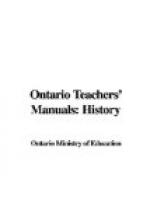2. Facts that we wish to remember should be grouped, or studied in relation to other facts with which they are vitally connected. The facts of history should be presented to the class in their relation of cause and effect, or associated with some larger centre of interest; in other words, pupils must understand, in some degree, what they are asked to remember. (See pp. 92, 97.)
3. If we increase the number of connections for facts, we are more likely to remember them. It is largely for this reason that history should be taught with correlated subjects, such as geography, literature, science (inventions), etc. For example, the story of the Spanish Armada is remembered better if we have read Westward Ho! and the story of the Renaissance is made clearer and is therefore remembered better, if we connect with it the inventions of printing, gunpowder, and the mariner’s compass. (See p. 121.)
4. Repetition is necessary to memory. Facts or groups of facts must be repeated to be remembered. This is the purpose of the drills which are necessary to good teaching, but are only a part of it. Reviews are not to be considered merely as repetitions, but should be treated more as aids to better understanding. (See p. 31.)
CHAPTER III
CORRELATION OF SUBJECTS
HISTORY AND GEOGRAPHY
These subjects are very intimately related, and each should be used in teaching the other. Geography, which is often called one of the “eyes of history,” may be used in the teaching of this subject in two ways. In the first place, an account of an historical event lacks, to a certain degree, reality in the minds of the pupils if they do not know something of the place where it occurred. Accordingly, in studying or teaching history, reference should be constantly made to the map to give a local setting to the story. The voyage of Columbus, the operations of Wolfe, the coming of the Loyalists, are made more real if they are traced out on the map, and are therefore better understood and remembered by the pupils. For this purpose, it is better, in most cases, to use an outline map, which may be sketched on the black-board by the teacher or the pupils, because on the ordinary wall maps there are so many names and so much detail that the attention may be distracted. Many of the details on the map are, moreover, more modern than the events that are to be illustrated, so that wrong impressions may be given.
In the second place, it must be kept constantly in mind that many events in history have been influenced by the physical features of a country. For example: the lack of a natural boundary between France and Germany has led to many disputes between these countries; the fact of Great Britain being an island accounts for many things in her history (see p. 108); the physical features of Quebec and Gibraltar explain the importance of these places; and the waterways of Canada account for the progress of early settlement. The climate and soil of a country affect its history; treaties are often based on physical conditions, and trade routes determined by them; a nation’s commerce and wealth depend largely on the character of its natural resources.




